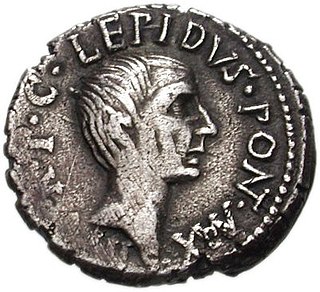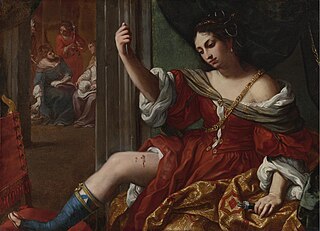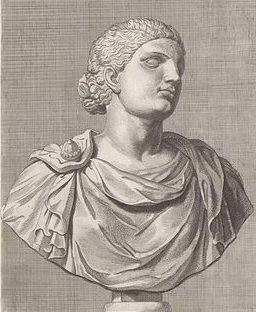
Marcus Antonius, commonly known in English as Mark Antony, was a Roman politician and general who played a critical role in the transformation of the Roman Republic from a constitutional republic into the autocratic Roman Empire.

Marcus Aemilius Lepidus was a Roman general and statesman who formed the Second Triumvirate alongside Octavian and Mark Antony during the final years of the Roman Republic. Lepidus had previously been a close ally of Julius Caesar. He was also the last pontifex maximus before the Roman Empire, and (presumably) the last interrex and magister equitum to hold military command.
Publius Cornelius Dolabella was a Roman politician and general under the dictator Julius Caesar. He was by far the most important of the patrician Cornelii Dolabellae but he arranged for himself to be adopted into the plebeian Cornelii Lentuli so that he could become a plebeian tribune. He married Cicero's daughter, Tullia, although he frequently engaged in extramarital affairs. Throughout his life he was an extreme profligate, something that Plutarch wrote reflected ill upon his patron Julius Caesar.
Servilia was a Roman matron from a distinguished family, the Servilii Caepiones. She was the daughter of Quintus Servilius Caepio and Livia, thus the half-sister of Cato the Younger. She married Marcus Junius Brutus, with whom she had a son, the Brutus who, along with others in the Senate, would assassinate Julius Caesar. After her first husband's death in 77, she married Decimus Junius Silanus, and with him had a son and three daughters.

Porcia, occasionally spelled Portia, especially in 18th-century English literature, was a Roman woman who lived in the 1st century BC. She was the daughter of Marcus Porcius Cato Uticensis and his first wife Atilia. She is best known for being the second wife of Marcus Junius Brutus, the most famous of Julius Caesar's assassins, and appears primarily in the letters of Cicero.
Masters of Rome is a series of historical novels by Australian author Colleen McCullough, set in ancient Rome during the last days of the old Roman Republic; it primarily chronicles the lives and careers of Gaius Marius, Lucius Cornelius Sulla, Pompey the Great, Gaius Julius Caesar, and the early career of Caesar Augustus. It spans from January 1, 110 BC through to January 16, 27 BC.
Marcus Livius Drusus Claudianus was a senator and praetor of the Roman Republic. He was born with the name Appius Claudius Pulcher, into the patrician family of the Claudii Pulchri but adopted by a Livii Drusi as a small child. His daughter Livia Drusilla became the wife of the first Roman Emperor Augustus, and he was a direct ancestor of the Julio-Claudian emperors Tiberius, Caligula, Claudius and Nero.

Calpurnia was either the third or fourth wife of Julius Caesar, and the one to whom he was married at the time of his assassination. According to contemporary sources, she was a good and faithful wife, in spite of her husband's infidelity; and, forewarned of the attempt on his life, she endeavored in vain to prevent his murder.
Quintus Servilius Caepio was a Roman patrician, statesman and soldier. He was the son of Quintus Servilius Caepio who was consul in 106 BCE and who lost his army during the Battle of Arausio. He was elected praetor some time in the last 90s BC and fought for Rome during the Social War. He was killed in the second year of the war while fighting the Marsi by Quintus Poppaedius Silo.
Publius Servilius Isauricus was a Roman senator who served as consul in 48 BC together with Julius Caesar. He is generally regarded as a puppet of Caesar, having a long friendship with the Dictator.

The Ides of March is an epistolary novel by Thornton Wilder that was published in 1948. It is, in the author's words, 'a fantasia on certain events and persons of the last days of the Roman republic. Historical reconstruction is not among the primary aims of this work'. The novel deals with the characters and events leading to, and culminating in, the assassination of Julius Caesar.

The October Horse is the sixth novel in Colleen McCullough's Masters of Rome series.
Servilia, also known as Servilia Minor or Servilia the Younger was the second wife of Lucullus.
Marcus Junius Brutus was a plebeian tribune of the Roman Republic in 83 BC and the founder of the colony in Capua. He was an associate of Marcus Aemilius Lepidus, who led a revolt against the senate after the death of Sulla. He was captured by Pompey and treacherously executed. He was the father of a homonymous son, who assassinated Julius Caesar in 44.
Quintus Servilius Caepio was a Roman aristocrat, and the adoptive father of Brutus, the assassin of Julius Caesar.
Livia Drusa was a Roman matron. She was the daughter of Marcus Livius Drusus, consul in 112 BC, and sister of Marcus Livius Drusus, tribune of the plebs in 91 BC. She was the mother of Cato the Younger, and grandmother of Marcus Junius Brutus, through her oldest daughter Servilia.
Tertulla was the wife of Marcus Licinius Crassus, the richest man in Rome, and the mother of his two sons.
Postumia was an ancient Roman woman of the late Roman Republic, she was the wife of Roman lawyer Servius Sulpicius Rufus and a mistress of Julius Caesar.
Lollia was an Ancient Roman noblewoman. She was the wife of Roman general Aulus Gabinius. She was also a mistress of Julius Caesar.

Servilia was an ancient Roman woman who was the wife of Marcus Aemilius Lepidus Minor, the son of the triumvir and Pontifex maximus Lepidus. She may also have been the same Servilia who was at one time engaged to Octavian.








